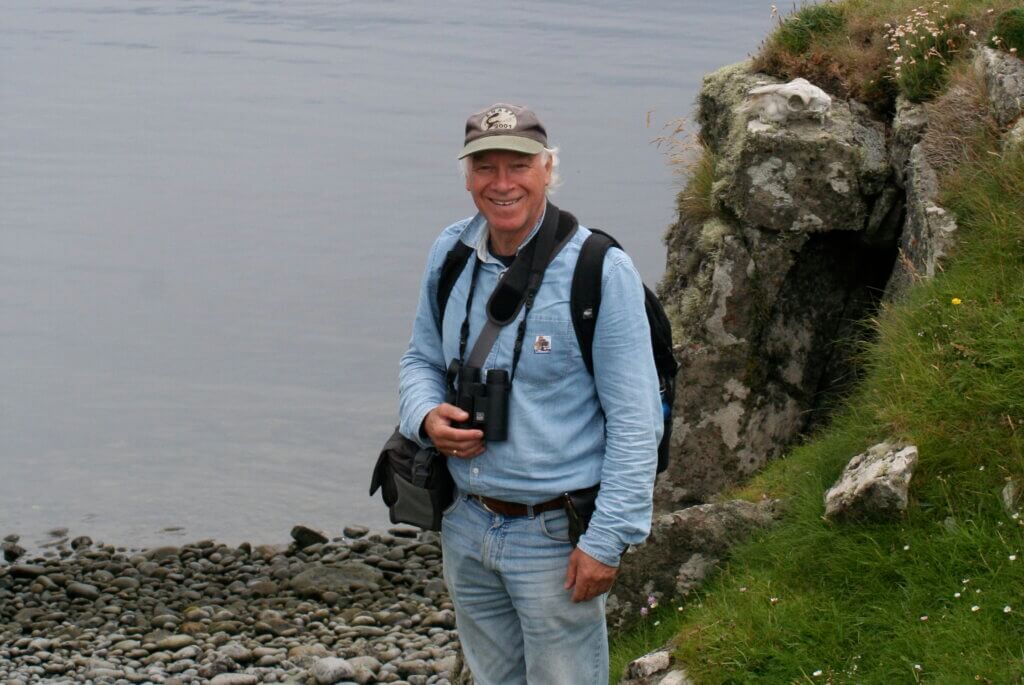
Dr Euan Dunn MBE is an ecologist who lives in Great Eversden near Cambridge. For 25 years he led on developing marine conservation policy for the RSPB and was awarded the Society’s medal in 2024. Not long after retirement he turned his attention from sea to land to assist Cambridge Approaches – click here – a grassroots campaign group against building a brand new section of East West Rail (EWR) between Bedford and Cambridge. Unless EWR can be stopped in its tracks, it will slice through the nature-rich countryside of South Cambridgeshire, fragmenting the landscape and inflicting irreparable damage on protected flora and fauna, including the Barbastelle bat.
East West Rail: HS2’s Badly Behaved Little Brother
Just up the hill from where I live in South Cambridgeshire lies Eversden and Wimpole Woods, a mixture of ancient coppice and high forest woodland first cited in the Domesday Book. In the weathered crevices of some tall mature trees, one of the UK’s rarest bats, the red-listed Barbastelle, finds haven for giving birth to its pups in summer. To conserve this precious maternity roost, in 2003 the woodland was designated a Special Area of Conservation (SAC), the highest UK level of site protection, and one of only five English SACs designated for Barbastelles.
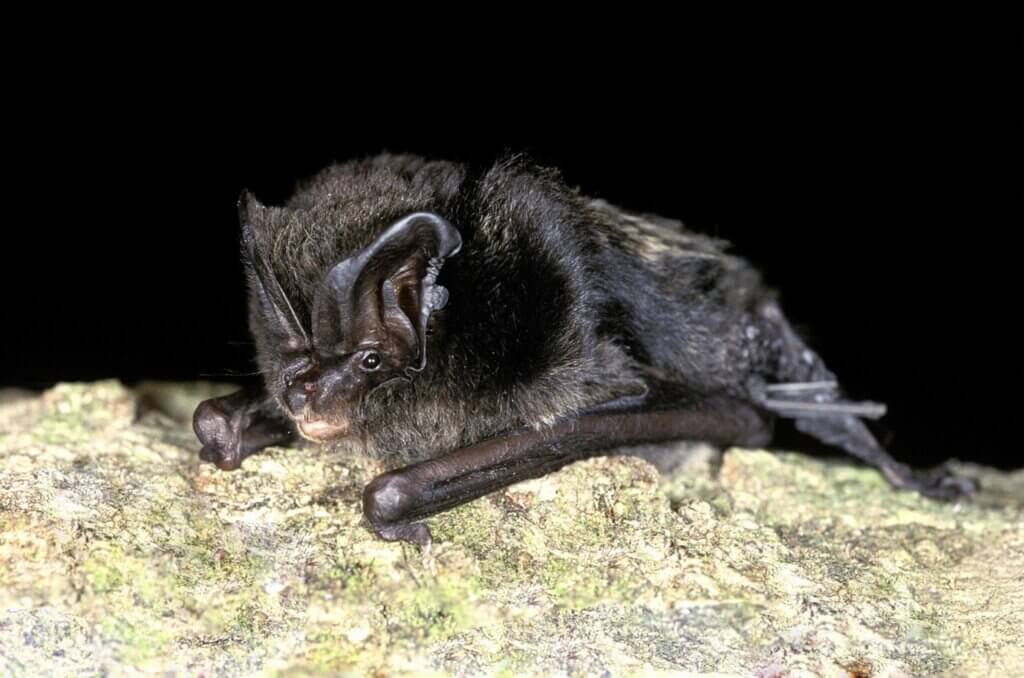
Some twenty years ago, radio-tracking by the Cambridgeshire Bat Group showed that the highly mobile Barbastelle foraged as far as Grantchester, 10km from the SAC, but most flight paths converged on the micromoth-rich edges of the meandering Bourn Brook. For this wide-ranging bat, a radius of 6-7km from the maternity roost defines its Core Sustenance Zone (CSZ), a halo of habitat vital to the resilience and conservation status of the colony. The CSZ is ‘functionally linked’ to the SAC in that anything that threatens the CSZ poses an equal hazard to the SAC itself. As such, the CSZ is accorded the same level of legal protection as the SAC’s maternity roost.
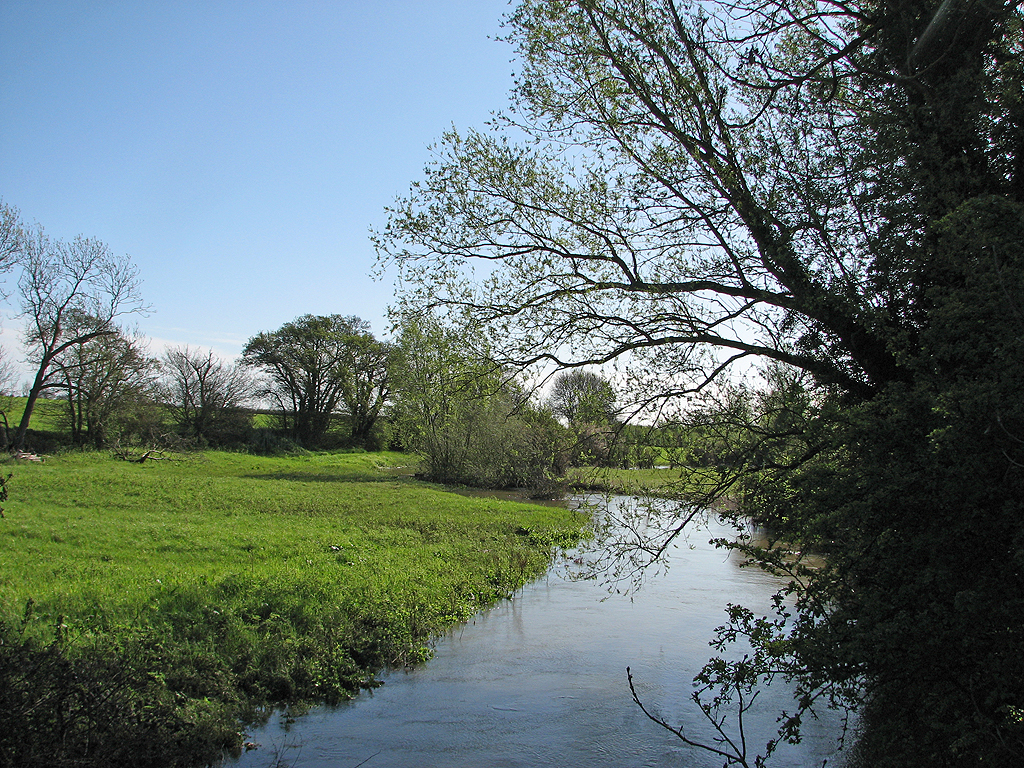
Little wonder, then, that conservationists are up in arms about the decision by Oxford-Cambridge East West Rail (EWR) to follow a route slicing right through the bats’ CSZ as the railway plunges through South Cambridgeshire towards the University city. The potential impact on the maternity roost of this so-called ‘southern approach to Cambridge’ (SATC) has recently been assessed by Cambridgeshire County Council as ‘unacceptable’ and ‘catastrophic’, including ‘in the worst-case scenario, loss of the maternity roost.’
In the map below prepared by Cambridge Approaches, Eversden and Wimpole Woods SAC is shown dark green in the centre of the 7km CSZ (ringed orange); from the north-west, EWR (grey line) crosses first Bourn Brook (blue) and then the River Rhee, a chalk stream, before turning north towards Cambridge.
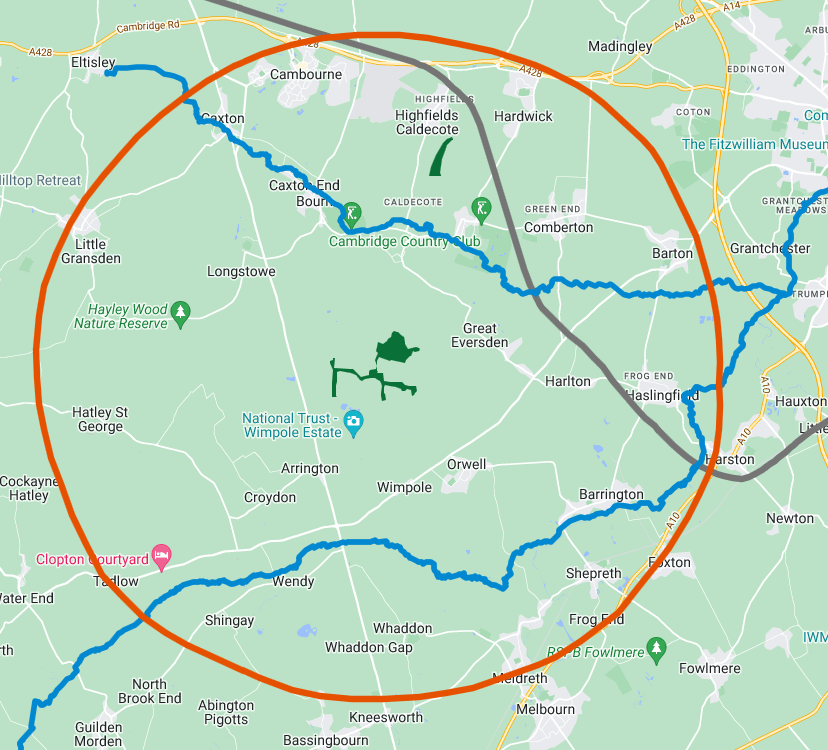
Just as the developers of HS2 route planning should have known about and avoided bat-sensitive woodlands years before they ploughed on, EWR has had years to come up with a route that steered well clear of the Eversden and Wimpole Woods maternity roost and its CSZ. Moreover, EWR has been highly secretive about what it did know and when, so FOI requests were required to force disclosure of the results of two radio-tracking surveys conducted by EWR for Barbastelles caught and tagged in, respectively, the SAC (2020 survey) and outlying parcels of woodland (2022 survey), most of which are SSSIs.
In EWR’s 2022 survey, a previously unknown Barbastelle maternity roost was discovered in Hardwick Wood SSSI (the dark green sliver of woodland near Highfields Caldecote at the top of the map, above). The eastern edge of Hardwick Wood is only 700m from the nearest proposed construction compound for the railway, exposing the maternity roost to years of disruption (habitat loss, noise, light pollution etc), and its possible abandonment, well before a train ever runs on the track.
In the 2022 survey report provided on FOI request, EWR totally redacted the mapped Figures showing the calculated home ranges, core foraging areas and flight paths of the Barbastelles, on the grounds that putting them in the public domain would breach the Environmental Information Regulations (EIRs) and expose the bats to risk from ‘e.g. photographers, nature watchers, or even poachers’. Who said irony was dead?
EWR’s failure to disclose the Barbastelles’ flight paths is particularly egregious as it denies the opportunity for public scrutiny of the correct alignment between these and EWR’s proposed mitigation measures in the shape of bat crossings, i.e. green bridges and underpasses. This is critical because, as EWR itself has conceded, key flight paths need to align precisely with crossing structures to facilitate safe passage of the bats across the railway. Even with exact alignment, however, there is no scientific evidence that Barbastelles will even use green bridges and underpasses, at least in sufficient numbers (> 90% of the Barbastelles is the effectiveness threshold suggested from studies of other bat species) to avoid severing flight lines and collision risk with trains.
Although EWR is keeping stum about the flight paths its own surveys have revealed, radio-tracking by the Cambridgeshire Bat Group had already indicated key Barbastelle flight paths (purple lines in the Cambridge Approaches map, below) from the maternity roost in Eversden and Wimpole Woods SAC. As mentioned earlier, the strongest direction of travel is NE towards the Bourn Brook corridor which offers rich foraging conditions. Flight lines cross the proposed EWR route (grey line) in a number of places, some of which co-locate with EWR’s latest proposed mitigation measures (red dots), whether green bridges or underpasses. EWR says it plans to finesse such mitigation deployment with further surveys.
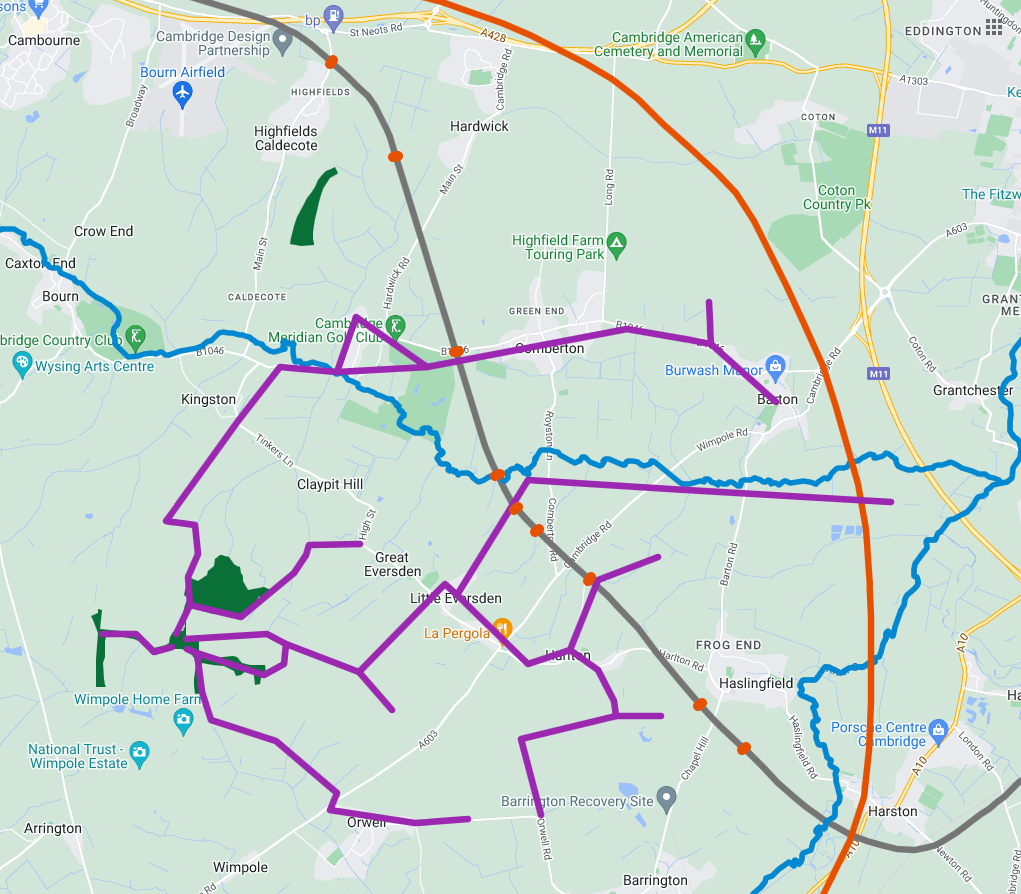
But while crossing structures may possibly provide some mitigation for Barbastelles on the outrun from the maternity roost to forage, they are unlikely to be effective for return trips. Studies have shown that Barbastelles exiting at dusk first follow routine flight paths along hedgerows and tree lines for safety from predators, especially owls. However, once under the cover of darkness, they fan out to forage and finally fly directly back to the roost. In other words, they cross the EWR route alignment on a broad front, which seriously undermines the effectiveness of siting mitigation structures at fixed locations.
Recognising the special significance of the Bourn Brook to the Barbastelles, EWR proposes to build a viaduct over it to mitigate flight path severance. However, from the viaduct south for 2km, the railway is planned to be embanked up to a height of 11m (the so-called ‘Great Wall of South Cambridgeshire’), adding yet more jeopardy to the Barbastelles. As the bats typically fly at heights of up to 5m, surmounting this massive embankment – plus the added height of any overhead power cables (railway catenary) and fencing for security or noise abatement – creates a major barrier effect and increased collision risk. This threat is compounded by the high volume of rail traffic proposed to operate around the clock on EWR’s twin track, with the prospect of freight trains over 750m long running more often at night to free up the line by day for passenger trains.
Mortality risk apart, crossing such a high embankment is energy-sapping, especially for heavily pregnant females with reduced agility, and lactating females which may return to the maternity roost several times a night. The embankment may prove particularly disorientating for naive juveniles, which are known to range up to 7km from the colony, jeopardising their ability to find the mitigation structures intended as safe crossing points.
Like most bat species, the Barbastelle’s relatively long life-expectancy, low reproductive rate and extended post-natal care all add up to a slow generation turnover, making colonies highly vulnerable to excessive mortality or breeding failure. The chronic EWR-related loss of just one or two adult females a year could therefore pose an existential threat to the SAC’s Conservation Objective of maintaining the long-term population stability of the maternity roost.
The southern approach to Cambridge, dictated by EWR’s obsession on connecting first to Cambridge Biomedical Campus as an unjustified crucible of growth, flies in the face of the well-established ‘mitigation hierarchy’ in which project proposals must prioritise avoidance over mitigation for limiting adverse impacts on biodiversity. In riding roughshod over this principle, just as HS2 did, EWR rejected the inconvenient advice of Arup, its own Technical Partner, that the alternative route to Cambridge from the north was the better option on nearly every metric, not least in being less environmentally damaging and generating 43% less embedded carbon.
EWR faces a clear choice: insist on a southern route to Cambridge that will cause untold environmental damage or swallow their own experts’ recommendation to opt for the northern route that’s cheaper, cleaner, and better for bats and people. To this end, a Cambridge Approaches-initiated Parliamentary Petition https://petition.parliament.uk/petitions/701546 is calling for the plans for Bedford-Cambridge section of EWR to be paused pending a full transparent and independent review. Please do sign the petition and share it widely.
In recent weeks, the political landscape has changed dramatically to deepen the jeopardy for South Cambridgeshire’s Barbastelles bats and the environment at large, not just for EWR but for all infrastructure projects. In her bid to boost economic growth, Chancellor Rachel Reeves has declared that developers need not worry about bats and newts, and that for EWR the Government would not countenance costly mitigation measures as it did for the HS2 bat tunnel.
The Government then doubled down on its agenda to hollow out infrastructure planning, including its shamefully petty proposal that the requirement on Local Planning Authorities to consider the Bat Conservation Trust’s Bat Survey Guidelines be removed entirely from Natural England’s standing advice. As Natural England and the UK’s leading voices on conservation have pointed out, the Government’s attempt to prioritise cost over nature conservation is a false dichotomy, and a highly dangerous one at that. In this context EWR is emerging as a defining test case and one we cannot afford to lose.
**************************
If you would like to write a guest post for this blog – please stick to this guidance
To see many of the frequent guest bloggers using this site and get links to their writing – click here
[registration_form]
Source link




